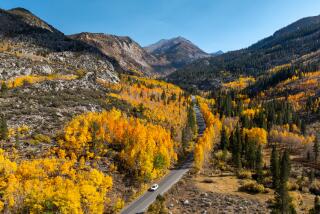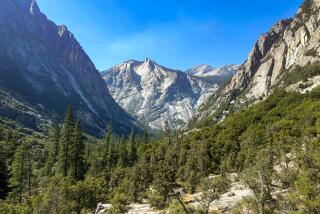Guests Among the Giants
SEQUOIA NATIONAL PARK, Calif. — It’s always a joy to soak up the splendor of Sequoia, but the park inspires a special sort of wonder in the off-season. Freed from its yoke of tourist buses and crowded picnic grounds, the region has a stillness and grandeur that give you a glimmer of what naturalist John Muir must have felt when he first explored its expanse in the 1880s, marveling at the towering trees, writing in his journal that “one naturally walked softly and awe-stricken among them.”
I made the trip last October with my wife, Sonja, and my son, Luke, 18 months old at the time. We were motivated to visit, in part, by Wuksachi Lodge, the 102-room year-round hotel that opened in June 1999, replacing the venerable Giant Forest Village.
Visitors wanting to experience the lodge and the park at their off-season best can try to sneak in now, before the most popular month of August, or better yet, begin planning a visit for the fall. If you can’t wait until then, don’t worry: Even during the peak late-summer months, you can escape the crowds if you take time to explore the park’s miles of back-country trails.
We started out on a Saturday, driving from Los Angeles north on Interstate 5, then Highway 99, then east on Route 180 into the park, a five-hour trip.
The old Giant Forest Village was a cluster of 300 aging buildings that included cabins, shops and a lodge. They had a certain ramshackle charm, but park officials--and many park fans--thought the buildings and parking lots spoiled the natural surroundings and were hazardous to the nearby sequoia trees, whose shallow root systems were stressed.
Wuksachi Lodge was built on a less densely forested site, and the final part of the old village was torn down last November. The lodge is composed of three buildings with guest rooms and a fourth structure housing the huge dining room, a gift shop and a communal area where you can sit by a roaring fire.
The lodge’s exterior is plain. The interior design is far more pleasing to the eye, with high ceilings, lots of cedar and stone, big windows and an understated Native American-style decor.
Guest rooms are comfortable but bland, with many overlooking parking lots. We sprang for a higher-priced “superior room,” which had an additional sitting area and nice views of the Western Divide. (New rates, effective through Oct. 8, are $120 for a “standard room,” $145 for a larger “deluxe room” with a table and chairs, and $165 for an even larger “superior room”; off-season rates are about 37% less.)
The dining room’s menu was simple, but it had all the staples of high-end park dining, with an assortment of steak, fish, chicken and game for dinner. Our favorites included a pan-fried trout with pistachio sauce and roasted chicken with rosemary and shallots. The new menu includes such fare as rib-eye steak with chipotle jus, and fettuccine with applewood bacon, mozzarella, caramelized onions and wild mushrooms.
The breakfast menu offered several egg dishes, pancakes and seasonal fruit, though many visitors opted for an extensive buffet.
Despite the smaller off-season crowd, we often faced a traffic jam at the dining room, where the wait for dinner was 90 minutes. You can expect similar delays over the next few years, while the lodge builds a cafeteria and a market.
Our only other options were to make the 20-minute drive to Grant Grove Village in neighboring Kings Canyon National Park, where we had a hearty dinner one night, or to stop at Lodgepole Campground a few minutes away. It has a ranger station, a snack bar serving breakfast and lunch, and a store with fixings for sandwiches.
Sunday morning, we had breakfast at Lodgepole, then visited the legendary General Sherman Tree at Giant Forest, a few miles south of our lodge. We didn’t have to share the view with anybody. It was just the three of us and Sequoia Maximus: 2,700 years old, 275 feet tall and nearly as wide as our house. It’s not the world’s tallest tree, but according to the National Park Service, it’s the most massive in bulk.
We hiked the Crescent Meadow Loop, an easy trail that winds past a burned-out sequoia known as the Chimney Tree and Tharp’s Log, a 19th century prospector’s cabin carved out of a felled sequoia. One must-visit spot is Moro Rock. It’s a steep, 300-foot climb, but once you’re on top, you have a breathtaking view of the Western Divide, the Kaweah River gorge and the hazy edges of the San Joaquin Valley.
If you’re feeling adventuresome, drive back to Lodgepole and take the Tokopah Falls Trail. The trail head, at the end of the campground, led us off on a moderately strenuous two-mile hike up a box canyon that has a booming waterfall in spring and summer.
Monday morning we drove north on Generals Highway to Grant Grove, the main village in Kings Canyon.
Grant Grove has some of the best hikes in the park. We took the shady North Grove Loop up to a mound of rocks that looked out toward Sequoia Lake, a nearby YMCA campsite. We also drove up to Panorama Point, which offered a fine view of the park’s environs.
If you want the exercise, the Point is the beginning of a 4.5-mile hike that leads to the Park Ridge fire lookout. We paced ourselves because most of the park is at an elevation of 6,000 feet. But even hikers who go halfway will be rewarded with great views.
A five-mile hike into Redwood Canyon--in the Quail Flat area south of Grant Grove--took us past sprawling sequoia groves and offered eye-popping views of the western slope of the Sierra.
We didn’t see a soul on the hike until we returned to the trail head. As we were fixing a picnic lunch on a hollow sequoia log, we met Mike Faulkner, a friendly park ranger (and great-nephew of William Faulkner), who was eager to chat.
He explained that the denuded fir trees we saw were the result of tussock moth caterpillars, which chewed needles off the trees. When the caterpillar population reaches a certain level, they succumb to a virus that kills their larvae, so most firs should survive.
Sequoia’s long-term survival isn’t entirely secure. According to park ranger data, Sequoia has the worst summertime smog of any national park in America, the result of air inversions from the Central Valley. Scientists are still studying the effects on the trees, but they think the smog is hindering the survival of seedlings.
The worrisome news made our visit a touch bittersweet. Standing at the foot of nature’s most epic behemoths made our spirits soar. They looked indestructible, having survived centuries of fires and floods and rapacious 19th century loggers. Maybe they’ll survive our smog too.
(BEGIN TEXT OF INFOBOX / INFOGRAPHIC)
Budget for Two
Wuksachi Lodge, two nights: $231.00
Breakfast, Wuksachi: 22.45
Dinner, Wuksachi: 43.43
Breakfast, Lodgepole snack bar: 11.58
Lunch, Lodgepole market: 13.62
Dinner, Grant Grove restaurant: 25.74
Gas: 24.82
FINAL TAB:: $372.64
Wuksachi Lodge, P.O. Box 89, Sequoia National Park, CA 93262; tel. (888) 252-5757 or (559) 253-2199, Internet https://www.visitsequoia.com/html/wuksachi.html.
*
Patrick Goldstein writes for The Times’ Calendar section.
More to Read
Sign up for The Wild
We’ll help you find the best places to hike, bike and run, as well as the perfect silent spots for meditation and yoga.
You may occasionally receive promotional content from the Los Angeles Times.






